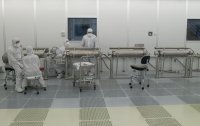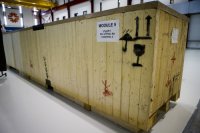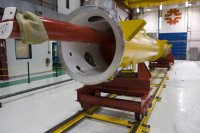 |
 |
|||||||||||||
|
|||||||||||||
|
|||||||||||||
|
The 1200 parts started to arrive at Fermilab in June. When fully assembled, these many parts will make up the first cryomodule for International Linear Collider R&D in the United States. The ILC will ultimately require 1680 of these cooled modules that hold the superconducting cavities, maintaining a temperature only two degrees above absolute zero. This first US cryomodule -which will only be used for R&D purposes-represents a special collaboration between Fermilab and DESY. Known as the “cryomodule kit,” all 1200 parts, including instructions, come from DESY in Hamburg, Germany. In addition to having the first cryomodule to test in the US, putting the kit together ultimately serves as a learning exercise - for both laboratories involved. Fermilab's Tug Arkan compares the cryomodule kit to buying a piece of furniture at IKEA. The furniture may come with instructions, but building it is not always simple. This is why a Fermilab Cryomodule Assembly Facility team spent six weeks at DESY during a cryomodule assembly last year to observe and record the assembly processes. It is also why teams of technicians from DESY will spend weeks at a time at Fermilab this year to assist during each stage of the cryomodule assembly. DESY's Axel Matheisen and two technicians spent a week at Fermilab in July to help string the first four superconducting cavities together inside Fermilab's clean room. (The cryomodule will contain a total of eight cavities.) Unable to enter the clean room himself, due to a cold that could have potentially contaminated the cavities, he communicated with the technicians inside via an intercom. “Both labs benefit,” he said. “Fermilab learns how to build cryomodules, and DESY learns how to teach others to build it.” These teaching skills will be crucial for passing knowledge on to industry, where the majority of the 1680 cryomodules for the ILC will be built. Next week, Matheisen will return to Fermilab with another of team of DESY technicians to assist the Fermilab team during the second phase of stringing the other four cavities together. Once the eight-cavity string is complete, a different DESY team led by Kay Jensch and Rolf Lange will come to assist Fermilab Cryomodule Assembly Facility technicians in the Cold Mass Assembly - the components that cool the cavities and power the cryomodule. Called a Cold Mass at this point, a team of technicians will transport it roughly a mile from the MP9 building over to the other half of Fermilab's Cryomodule Assembly Facility at the Industrial Center Building in mid October. Technicians will then align it and insert it into a vacuum vessel. Matheisen and Jensch explained that DESY will send out a different technical team for each phase so that as many of their technicians as possible can gain the teaching experience and all knowledge can be transferred to Fermilab's Cryomodule Assembly Facility team. Fermilab expects to complete the kit later this autumn. The 12-metre-long vessel will then proceed to the lab's new ILC Test Area, a cryomodule test beam facility that is currently under construction. In addition to the cryomodule kit, Fermilab's role also includes designing, building and testing a 3.9 GHz cryomodule that will be shipped to DESY for the FLASH Free Electron Laser light source next year. Stay tuned to ILC NewsLine for further updates. -- Elizabeth Clements |
|||||||||||||
| © International Linear Collider |


